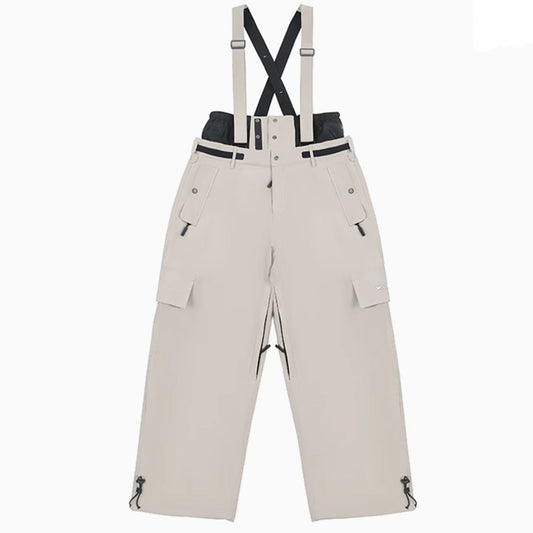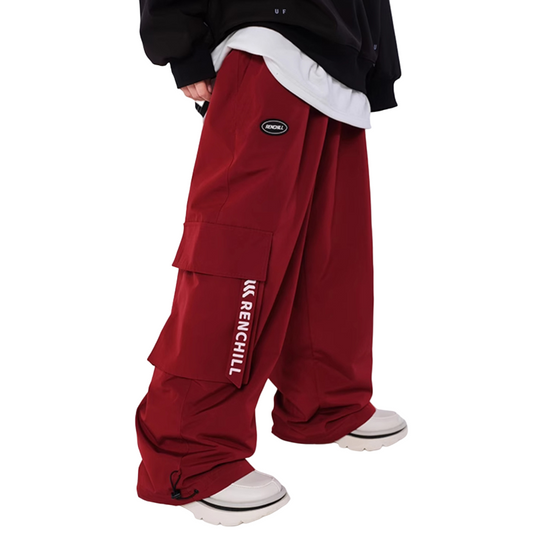Properly caring for your ski clothes, including knowing how to wash a ski jacket, helps maintain their waterproofing, insulation, and overall performance. Extend the life of your SNOWMOCACA Ski Jacket by following a few simple washing and care steps. These jackets are designed for durability, but regular maintenance ensures they’re always ready for your next adventure. Don’t forget to take advantage of SNOWMOCACA’s FREE SHIPPING On All Orders Over $99 and upgrade your gear today.
Key Takeaways
- Look at the care tag on your ski jacket before washing. This helps you follow the maker's rules to keep it waterproof and warm.
- Use detergents made for waterproof clothes. Normal soaps can harm the jacket's protective layers and make it less effective.
- Clean small stains on your jacket between washes to keep it looking good and working well. This means you won't have to wash it often, which can weaken the waterproof coating.
Preparing Your Ski Jacket for Washing
Check the Care Label for Specific Instructions
Before washing ski clothes, always check the care label on your jacket. Manufacturers include specific washing instructions to help you maintain the jacket’s waterproofing and insulation. Look for details about water temperature, detergent type, and drying methods. Following these care instructions ensures your jacket stays in top condition.
Some jackets require special detergents designed for technical outerwear. Avoid powder detergents, fabric softeners, and bleach, as they can damage the fabric. If you’re using a washing machine, clean the detergent compartment beforehand to prevent residue from affecting your jacket.
Turn Your Ski Jacket Inside Out
Turning your ski jacket inside out protects its outer layer during washing. This step minimizes wear on the waterproof coating and prevents scratches or damage to the fabric. It also allows the detergent to clean the inner lining more effectively, removing sweat and oils that accumulate during use.
When preparing ski clothes for washing, this simple step can make a big difference in preserving their performance.
Empty Pockets, Close Zippers, and Secure Velcro Flaps
Before washing, empty all pockets to avoid damaging the jacket or your belongings. Loose items like keys or coins can tear the fabric or scratch the waterproof coating. Close all zippers and secure Velcro flaps to prevent snagging during the wash cycle.
This preparation step also ensures the jacket maintains its shape and functionality after washing. Properly securing closures helps preserve the jacket’s design and keeps it ready for your next adventure.
Choosing the Right Detergent and Washing Method
Use Detergents Designed for Waterproof Fabrics
When cleaning your ski jacket, choosing the right detergent is crucial. Specialized detergents, like Nikwax Tech Wash or Granger's Performance Wash, are designed specifically for waterproof and breathable fabrics. These detergents clean effectively while preserving the jacket’s durable water-repellent (DWR) coating. Regular soaps, on the other hand, can strip away this protective layer, reducing the jacket’s waterproofing and breathability.
Specialized detergents also prevent residue buildup, which can compromise the jacket’s performance. They not only clean but also restore water-repellent properties, ensuring your jacket remains waterproof and breathable for longer.
Tip: Always check the product label to confirm it’s safe for waterproof fabrics before using any detergent.
Machine Washing vs. Hand Washing: Pros and Cons
Both machine washing and hand washing have their advantages when cleaning ski jackets. Machine washing is convenient and ensures a thorough clean, especially when using a delicate cycle. However, you must follow the care label instructions and use a front-loading machine to avoid damaging the fabric.
Hand washing offers more control and is gentler on waterproof fabrics. It’s ideal for jackets with delicate membranes or coatings. Although it requires more effort, hand washing minimizes wear and tear, helping your jacket last longer.
Choose the method that best suits your jacket’s material and condition. For heavily soiled jackets, machine washing with a specialized detergent may be more effective.
Avoid Regular Detergents, Fabric Softeners, and Bleach
Regular detergents contain harsh emulsifiers that can damage the waterproof coating on your jacket. Fabric softeners and bleach are even worse, as they can seal off the breathable membrane, making the jacket less effective. Even mild household detergents can leave residues that compromise waterproofing and breathability.
To protect your jacket, avoid these products entirely. Instead, stick to detergents specifically formulated for waterproof fabrics. These cleaners maintain the jacket’s protective qualities while ensuring it stays breathable and functional.
Expert Advice: Avoid using fabric softeners or stain removers on GORE-TEX or similar materials. These products can damage the waterproof membrane, reducing the jacket’s performance.
Step-by-Step Guide to Washing Ski Jackets
Setting the Washing Machine to a Delicate Cycle
Using a washing machine is one of the easiest ways to clean your ski jacket, but you need to set it up correctly to avoid damaging the fabric. Start by selecting the delicate cycle on your machine. This setting uses slower spin speeds and gentler agitation, which protects the jacket’s waterproof coating and insulation.
Use cold or lukewarm water to prevent shrinking or weakening the fabric. Add a detergent specifically designed for waterproof fabrics, ensuring it cleans effectively without stripping away the durable water-repellent (DWR) coating. Avoid overloading the machine, as this can lead to uneven cleaning and wear on your jacket.
Tip: Run an extra rinse cycle after washing to remove all detergent residue. Leftover soap can compromise the jacket’s waterproofing and breathability.
Washing by Hand: A Gentle Process
Hand washing is ideal for ski jackets with delicate membranes or coatings. Fill a large basin or bathtub with lukewarm water and add a small amount of specialized detergent. Submerge the jacket completely and gently agitate it to loosen dirt and oils. Focus on areas prone to buildup, such as cuffs, collars, and underarms.
Avoid scrubbing or wringing the fabric, as this can damage the waterproof layer. Instead, gently press the jacket to remove dirt and stains. For removing stubborn stains, let the jacket soak for 15–20 minutes before continuing the cleaning process.
Once you’ve finished washing, drain the basin and refill it with clean water. Rinse the jacket thoroughly to ensure no detergent remains.
Callout: Hand washing takes more time but guarantees proper care for your jacket, preserving its performance and extending its lifespan.
Rinsing Thoroughly to Remove Detergent Residue
Rinsing is a crucial step in washing ski clothes. Detergent residue can weaken the waterproof coating and reduce the jacket’s breathability. Whether you’re washing by hand or machine, ensure the jacket goes through a complete wash and rinse cycle.
For machine washing, use the extra rinse cycle to remove any lingering soap. If you’re rinsing by hand, repeat the process until the water runs clear. Pay special attention to seams and folds, where detergent can accumulate.
Proper rinsing not only removes stains and odors but also helps maintain the loft of down insulation in jackets. This step ensures your jacket stays clean and functional for your next adventure.
Note: Regularly applying waterproofing products after cleaning revives the fabric’s water repellency and enhances its insulating properties.
Drying Ski Jackets Properly

Air Drying vs. Tumble Drying: Best Practices
Air drying is the safest method for maintaining your ski jacket’s performance. Hang the jacket on a sturdy hanger or lay it flat on a drying rack in a well-ventilated area. This prevents damage to the waterproof coating and insulation. Avoid hanging the jacket near direct sunlight or heat sources, as these can weaken the fabric.
Tumble drying can be effective for reactivating the durable water-repellent (DWR) coating, but it requires caution. Use a low-heat setting and check the care label for specific instructions. High heat can damage technical fabrics, so monitor the drying process closely. If your jacket includes down insulation, tumble drying with dryer balls helps restore its loft.
Tip: Always remove the jacket promptly after tumble drying to prevent wrinkles and maintain its shape.
Using Low Heat to Reactivate Waterproofing
Low heat plays a crucial role in reactivating the DWR coating on your ski jacket. After washing, place the jacket in a dryer on a low-heat setting for 10–15 minutes. This gentle heat helps restore the water-repellent properties without compromising the fabric’s integrity.
If you prefer air drying, you can use a hairdryer on a low setting to target specific areas, such as seams and zippers. This method ensures the jacket remains waterproof while preserving its breathability.
Callout: Reactivating waterproofing after every wash keeps your jacket ready for unpredictable weather conditions.
Avoiding Direct Sunlight and High Heat
Direct sunlight and high heat can cause irreversible damage to technical fabrics like nylon and polyester. Prolonged exposure leads to fading, discoloration, and embrittlement, reducing the jacket’s durability.
|
Damage Type |
Description |
|---|---|
|
Fading of dyes |
Loss of color intensity due to light exposure. |
|
Discoloration |
Yellowing or browning of fabrics and yarns. |
|
Embrittlement |
Loss of strength, particularly in silk and nylon. |
To prevent these issues, dry your jacket indoors or in shaded areas. Limit sun exposure to preserve the fabric’s color and strength. Keeping textiles out of direct sunlight ensures long-lasting performance.
Note: Proper drying and storing ski clothes during the off-season also protect them from environmental damage.
SNOWMOCACA Ski Jackets: Built for Performance
Features of SNOWMOCACA Ski Jacket
SNOWMOCACA Ski Jackets are crafted with advanced technology to deliver exceptional performance on the slopes. These jackets feature GORE-TEX® technology, which ensures durable waterproofing and breathability. The three-layer GORE-TEX® construction enhances durability while optimizing comfort through techniques like Comfort Mapping. This method regulates heat loss in specific areas, keeping you warm without overheating.
The jackets also incorporate Zonal Technology, which customizes insulation levels across different body areas. This design improves heat retention and ensures maximum comfort during your ski adventures. High-wear areas, such as elbows and shoulders, are reinforced with Cordura fabric for added durability. Additionally, heavy-duty YKK zippers resist freezing and corrosion, while ripstop technology prevents small tears from spreading. These features make SNOWMOCACA Ski Jacket a reliable choice for any winter activity.
Why Proper Care Extends Their Longevity
Proper care is essential to maintain the performance and durability of your SNOWMOCACA Ski Jacket. Following the care instructions ensures the waterproof coating and insulation remain intact. Reinforced seams and double stitching provide strength, but regular maintenance prevents wear and tear from compromising these features.
Washing with specialized detergents and reactivating the durable water-repellent (DWR) coating after each wash helps preserve the jacket’s waterproofing. Proper care also includes storing the jacket in a cool, dry place during the off-season. These steps not only extend the jacket’s lifespan but also ensure it performs at its best every time you hit the slopes.
Explore SNOWMOCACA’s FREE SHIPPING On All Orders Over $99
Now is the perfect time to upgrade your ski gear with SNOWMOCACA Ski Jackets. Take advantage of the FREE SHIPPING on all orders over $99 and experience the unmatched performance of these jackets. Whether you’re a seasoned skier or a beginner, SNOWMOCACA Ski Jackets are designed to keep you comfortable and protected in any weather. Shop now and invest in gear that lasts for years to come!
Maintaining Waterproofing and Insulation
Reapplying Durable Water Repellent (DWR) Coating
Over time, your ski jacket’s water repellent coating can wear off due to regular use and cleaning. Reapplying a durable water repellent coating restores its ability to repel water and maintain breathability. You can use a spray-on or wash-in waterproofing treatment designed for technical fabrics. These products are easy to apply and help your jacket stay waterproof and breathable.
To reapply the coating, start by cleaning your jacket thoroughly. Dirt and oils can prevent the waterproofing treatment from bonding effectively. Once clean, follow the product instructions carefully. Spray-on treatments allow you to target specific areas, such as seams and high-wear zones. Wash-in treatments coat the entire jacket evenly, making them ideal for full coverage.
Tip: Reapply the durable water repellent coating after every few washes or when you notice water no longer beading on the surface. This ensures your jacket stays ready for wet and snowy conditions.
Storing Your Jacket Properly During the Off-Season
Proper storage during the off-season is essential for maintaining your jacket’s waterproof and insulating properties. Before storing, clean your jacket to remove dirt, sweat, and oils that can degrade the fabric over time. Once clean, hang the jacket on a sturdy hanger in a cool, dry place. This helps maintain its shape and prevents creases.
Using a breathable garment bag protects your jacket from dust and moisture while allowing air circulation. Avoid plastic bags, as they can trap humidity and lead to mildew. Inspect your jacket for any damage, such as tears or worn seams, before storing it. Addressing these issues ensures your jacket is in top condition when the next ski season arrives.
Steps for Proper Off-Season Storage:
- Clean your ski jacket thoroughly.
- Hang it on a sturdy hanger in a cool, dry place.
- Use a breathable garment bag for protection.
- Inspect for damage and make necessary repairs.
- Follow manufacturer recommendations for care.
By following these steps, you can extend the life of your jacket and ensure it performs well year after year.
Spot Cleaning Between Washes for Maintenance
Frequent washing can wear down your jacket’s waterproof coating, so spot cleaning is a great way to maintain it between washes. Focus on areas that accumulate dirt and oils, such as cuffs, collars, and underarms. Use a damp cloth or sponge with a small amount of specialized detergent for waterproof fabrics. Gently dab the stained area without scrubbing, as this can damage the fabric.
For tougher stains, let the detergent sit for a few minutes before wiping it away. Rinse the area with clean water to remove any residue. Spot cleaning not only keeps your jacket looking fresh but also reduces the need for full washes, preserving its waterproofing and insulation.
Callout: Regular spot cleaning helps you maintain your jacket’s performance while minimizing wear and tear from frequent washing.
How Often Should You Wash Ski Jackets?
Factors That Influence Washing Frequency
How often you wash your ski jacket depends on several factors, including how often you use it and the conditions you face. If you ski in wet or muddy environments, your jacket may require more frequent cleaning. Personal habits also play a role. Studies on outdoor apparel care reveal that many people wash their clothes too often, driven by psychological habits rather than necessity. Overwashing can wear down the waterproof coating and insulation, reducing your jacket’s performance.
Environmental considerations also matter. Washing less frequently reduces water and detergent use, which minimizes your environmental impact. When you do wash, maximize your machine’s capacity and use detergents designed for technical fabrics to protect your jacket and the planet.
General Guidelines Based on Usage
For occasional skiers, washing your jacket once or twice per season is usually enough. If you ski regularly or in harsh conditions, consider washing it every 5–10 uses. Always check for visible dirt or odors as indicators that your jacket needs cleaning. Proper care, such as using lukewarm water and air-drying, helps maintain its waterproofing and insulation.
Tips for Properly Washing Ski Clothes Between Uses
Between washes, spot cleaning is an effective way to keep your jacket fresh. Focus on high-contact areas like cuffs and collars. Use a damp cloth with a small amount of detergent designed for waterproof fabrics. After skiing, hang your jacket in a cool, dry place to air out and prevent mildew. These simple tips help extend the time between washes while preserving your jacket’s performance.
Advice: Avoid overwashing your ski jacket. Instead, focus on spot cleaning and proper storage to maintain its quality.
Properly washing ski clothes, like SNOWMOCACA Ski Jackets, ensures their waterproofing and insulation remain intact. Follow the steps outlined above to keep your jacket in peak condition. Regular care extends its lifespan and performance. Upgrade your gear today with SNOWMOCACA’s FREE SHIPPING on orders over $99 and enjoy your next adventure!
FAQ
How do I know if my ski jacket needs washing?
Check for visible dirt, odors, or reduced waterproofing. If water no longer beads on the surface, it’s time to clean your jacket.
Can I use regular detergent to wash my ski jacket?
No, regular detergents can damage waterproof coatings. Use detergents specifically designed for technical fabrics to maintain your jacket’s performance and durability.
How often should I reapply the DWR coating?
Reapply the durable water-repellent coating every 3-5 washes or when water stops beading on the jacket’s surface. This keeps it waterproof and breathable.
Tip: Always follow the care label instructions to ensure your jacket stays in top condition.


















